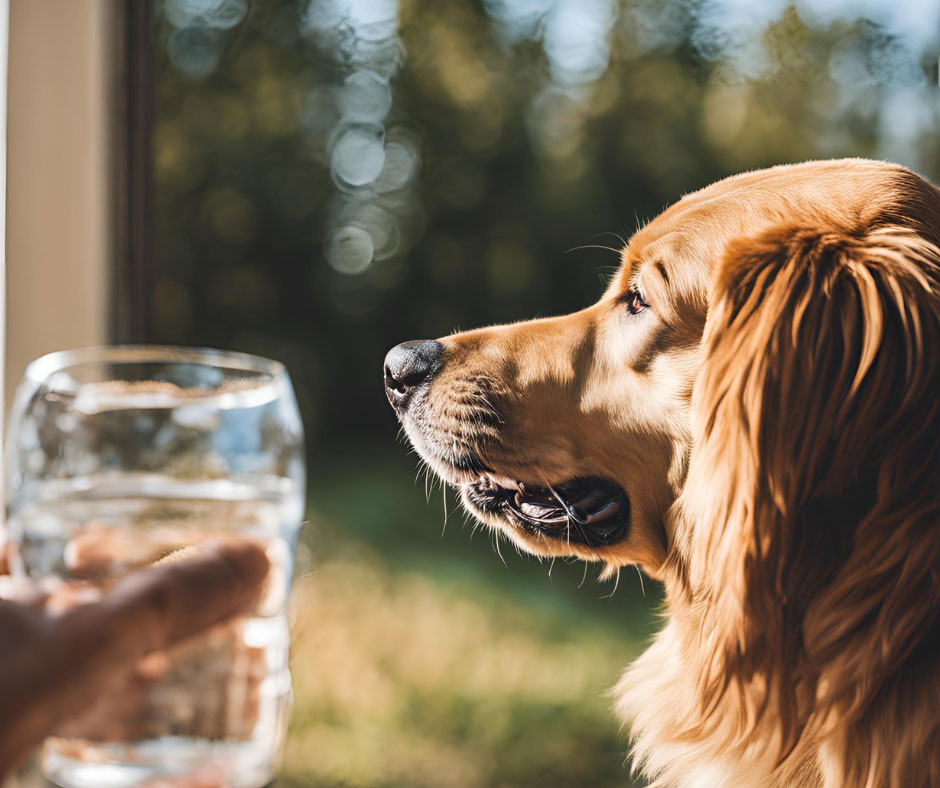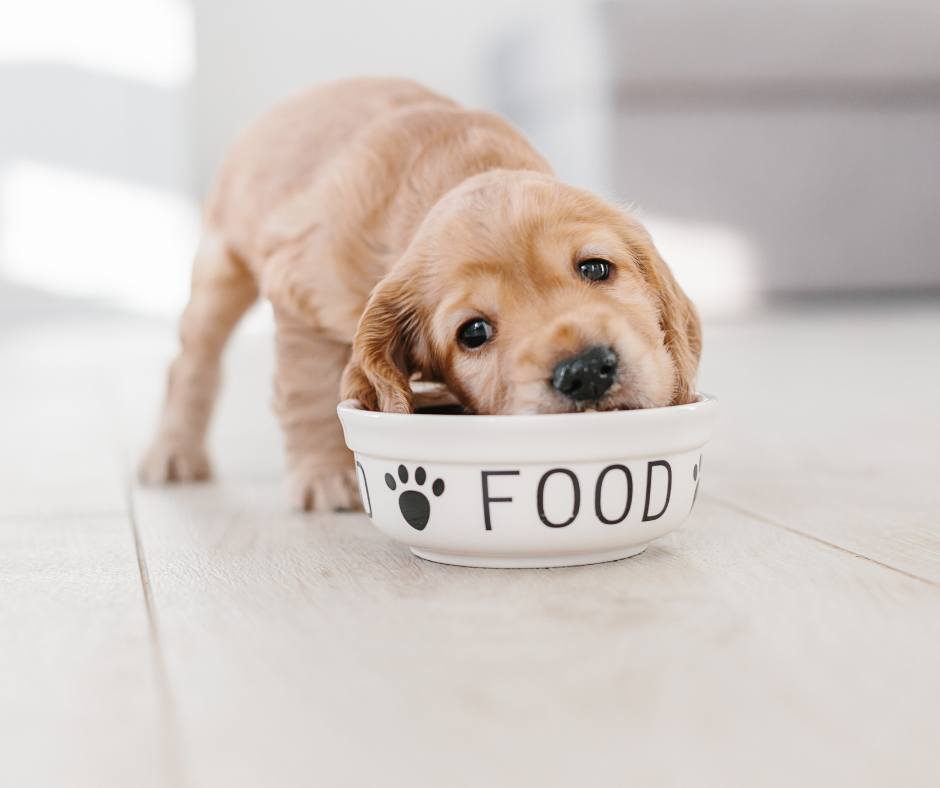
What is a model?
By basic definition: a model is a representation, structure, or description that one follows or repeats. In terms of a raw feeding model, it’s a breakdown of ingredients meant to represent the ideal ratios for a fresh food diet. There are many ways to feed fresh food, and using these models can be convenient, easy, and removes the guesswork. There are often calculators available to do the math for you once you chose a model, which is excellent for people like me who truly abhor mathematics!
Where did these models come from? For some, we can trace them back to their origin. For others, it’s unclear when they became mainstream. And truth be told, I’m sure there are many models out there that I’m not especially familiar with and won’t be mentioning here today. In the end, you want to do what works best for your dog and your lifestyle. Note that cats have slightly different needs, so the breakdown of these models don’t apply to our kitty cats today.
This article will go into detail about the three most common mainstream models of fresh feeding… and also introduce my own! After years of tinkering and debating putting it out for the world to see, I finally decided to make my own model public. Read on to become a fresh feeding model pro!
P.M.R.
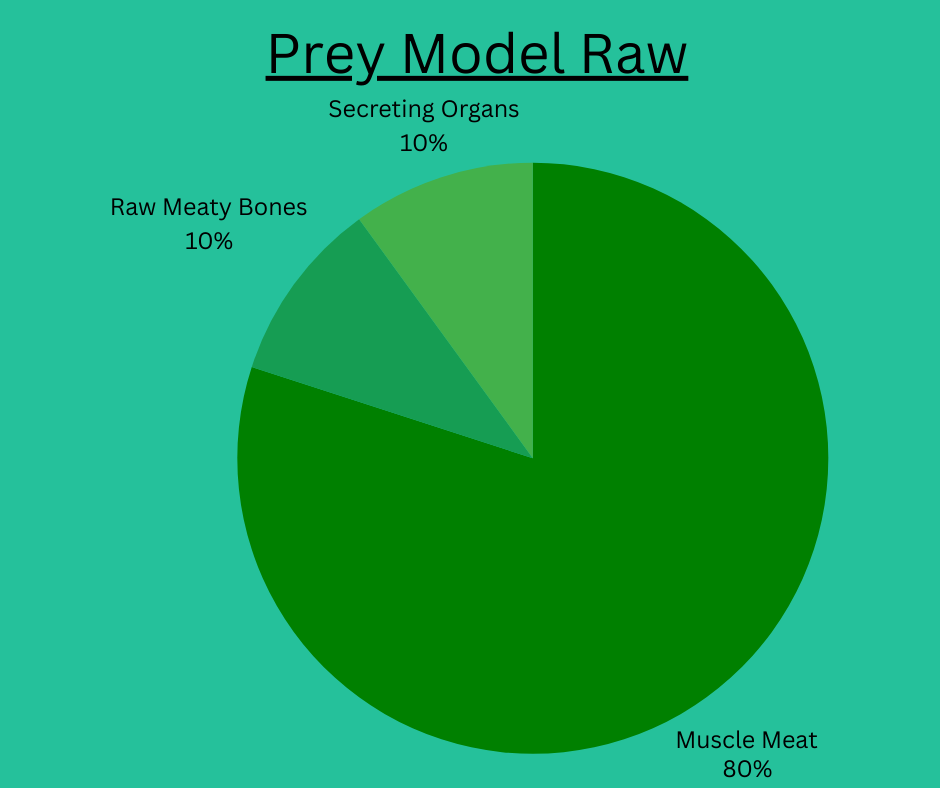
Let’s start with the simplest and easiest to understand. P.M.R., or prey model raw, has only three different categories: Meat, bones and organs. Easy to remember, easy to add together. The breakdown is thus:
- 80% muscle meat: This can be from any cut and any animal. Examples could be ground beef, beef chuck, pork loin, chicken breast and more. You can also include muscular organs in this portion, such as beef heart, chicken gizzards, pork lung, and so on and so forth. For a detailed explanation of muscular organs and how they fit in, see my article about Organs.
- 10% raw meaty bones (RMBs): Any bones will do, you just want to match them to your dog’s chewing style, dentition, and size. To get all the details on feeding bones, see my article about Bones!
- 10% organs: This category is broken up into 5% liver, and 5% other secreting organ. That other secreting organ could be kidney, spleen, brain, etc. Again, see my Organ article for more details.
As you can see, this feeding style is pretty straightforward! The simplicity is what attracts so many to this model, and it is generally easy to source the ingredients and prep them. However, there are downfalls with this model, which is why I don’t use it:
- Nutrient deficiencies: When feeding only meat, bone and organs from animals, the diet will usually be deficient in Omega 3s, Zinc, Manganese, Magnesium, Vitamin E and Vitamin D. This is because Omega 3s, Vitamin D, Manganese and Zinc are most predominant in fish and shellfish. Vitamin E tends to be found in seeds, nuts and oils, and Magnesium is abundant in vegetables. So even if you’re feeding 100% grass fed and pastured ruminants and poultry with the absolute best nutrient profiles, it would be very difficult to meet those nutrients needs on 80/10/10 alone.
- Lack of fiber and gut support: Plants and fungi provide the majority of the prebiotics and probiotics to the diet in the form of fiber. Rotating in low glycemic vegetables, fungi, fruit and seeds can provide a wide array of nutrients and fiber which feed the beneficial gut microbes and help them make postbiotics, which we need for our health. In fact, studies have shown that dogs fed a 100% meat-based diet often go on to develop microbiome disruptions and dysbiosis.
When choosing ingredients for this model, people will often source each category from a different animal. For example, one might feed beef chuck, pork kidney and chicken liver one day, then perhaps do ground turkey, lamb kidney and beef liver the next. When they mix and match animals, it’s often termed ‘Franken-prey’ because of how Frankenstein was pieced together in the old horror film. This is usually done by DIY fresh feeders. The other option is to feed each ingredient from 100% the same animal. Ground beef, beef kidney, beef liver one day, then lamb shoulder, lamb kidney and lab liver on another, etc. Generally, you’ll find companies selling premade grinds that are from one animal but of course can DIY this as well.
One thing to note about this model is that people often add toppers a few times a week in addition to the 80/10/10. You’ll often see people say “add a tin of sardines 3x/week” or “crack an egg into the bowl every other day” with the assumption that this infrequent addition of ingredients will fill nutrient gaps. I’m not convinced, and it leaves too much to chance.
This goes to show that easier isn’t always better. By adding a bit more variety into the bowl with non-animal based ingredients, you support the gut and your beneficial microbes and balance out nutritional needs.
B.A.R.F.
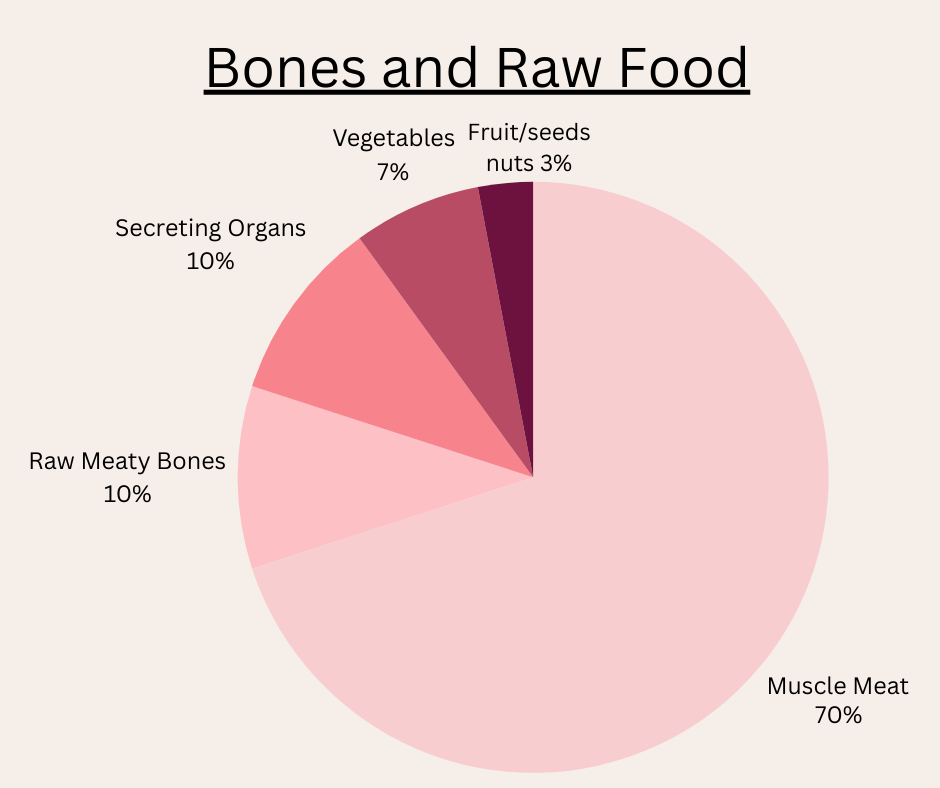
Next, we have B.A.R.F., or Bones and Raw Food. This was model originally coined by Dr. Ian Billinghurst in 1991 when he released his first book “Give Your Dog a Bone.” This book is an excellent foundational book by the way, and I’d highly recommend it to anyone getting started. Dr. B has other books and well and they deserve space on your bookshelf for sure!
A quick breakdown of the categories:
- 70% muscle meat, 10% RMBs, and 10% secreting organs: these are the same as PMR, including the secreting organs being split into 5% liver and 5% other secreting organ.
- 10% Vegetables, fruits, seeds and nuts: as noted above, these ingredients provide much needed prebiotics (food) for our microbiome, which is made up of a variety of probiotics. If you want to learn more, visit my blog about pre-, pro- and postbiotics! Generally, people tend to break this category up into about 7% veg and 3% everything else. A very important thing to remember- seeds pack a powerful punch in a small serving size. 1 tsp of seeds can provide a large amount of ALA, Magnesium, Manganese or other nutrients depending on which ones are used.
Overall, I think that this model can be a good choice when feeding fresh food, especially if there is a lot of variety present in the meat and vegetable ingredients chosen. However, the biggest drawback is the lack of any fish. I’ll go more into detail on fish below. Again, people often recommend ‘topping’ meals that follow this model with sardines or eggs a few times a week, but you already know how I feel about that.
Real Ancestral 6x Diet
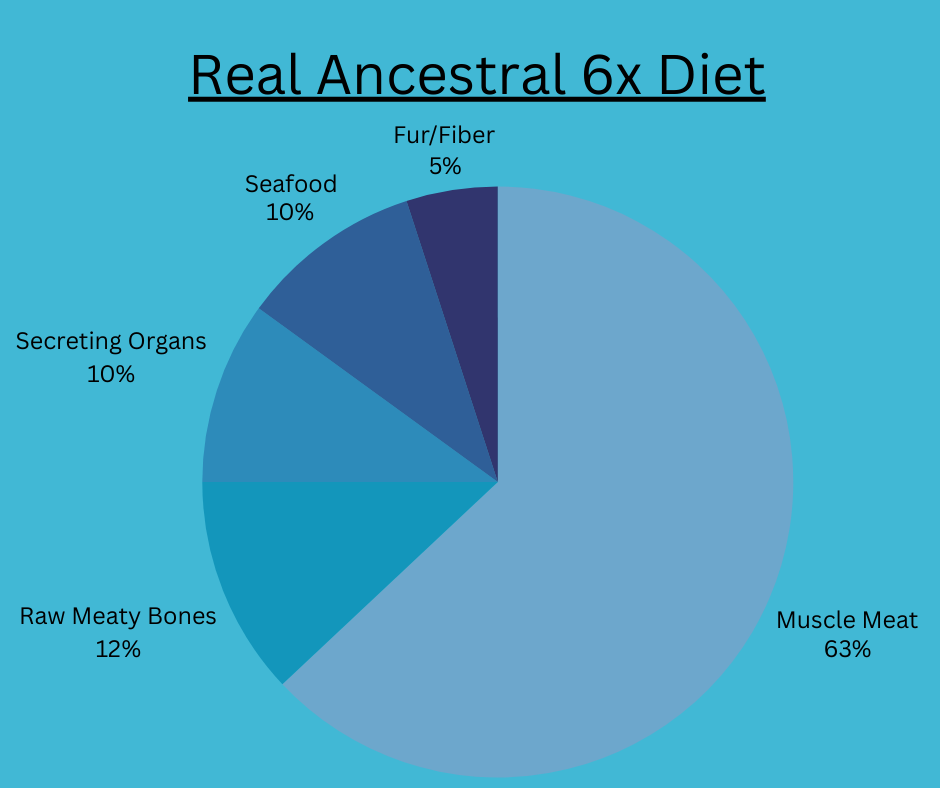
This model was created by the Feed Real Institute, and is featured on their website and both their pet parent and professional courses, which can be found here.
Of all the more well-known models to follow, this is by far my favorite. Let’s look at each section:
- 60-65% muscle meat: no different from muscle meat in the other categories!
- 10-15% RMB: this model recommends a little more bone than the others. This can impart more Calcium, Phosphorous, Zinc and Magnesium. Some of these nutrients are frequently deficient in homemade diets, so this can be beneficial. Not all dogs can tolerate a higher bone content however, as it may cause constipation.
- 10% organs: similarly, liver is 5% and another secreting organ is the other 5%. They specifically recommend beef, pork or lamb liver in their breakdown.
- 10% seafood: i truly believe that seafood bridges the gap in meeting nutrient needs due to soil depletion caused by factory farming and monocropping, and the inclusion of seafood in this model is, in my opinion, what makes it the best of all the well-known options to follow.
- 5% fur/fiber: fur can be a source of Manganese for dogs, although the amount truly absorbed is up in the air, since fur often comes out looking the same way it did when it went in! Fur is an insoluble fiber, which can help regulate bowel movements and acts as a prebiotic.
One of the pillars of this diet is the importance of variety and rotation. This is what allows for different nutrients to be included and the way the diet provides balance over time.
The Raw Paw Adventures Method: Vital Paws
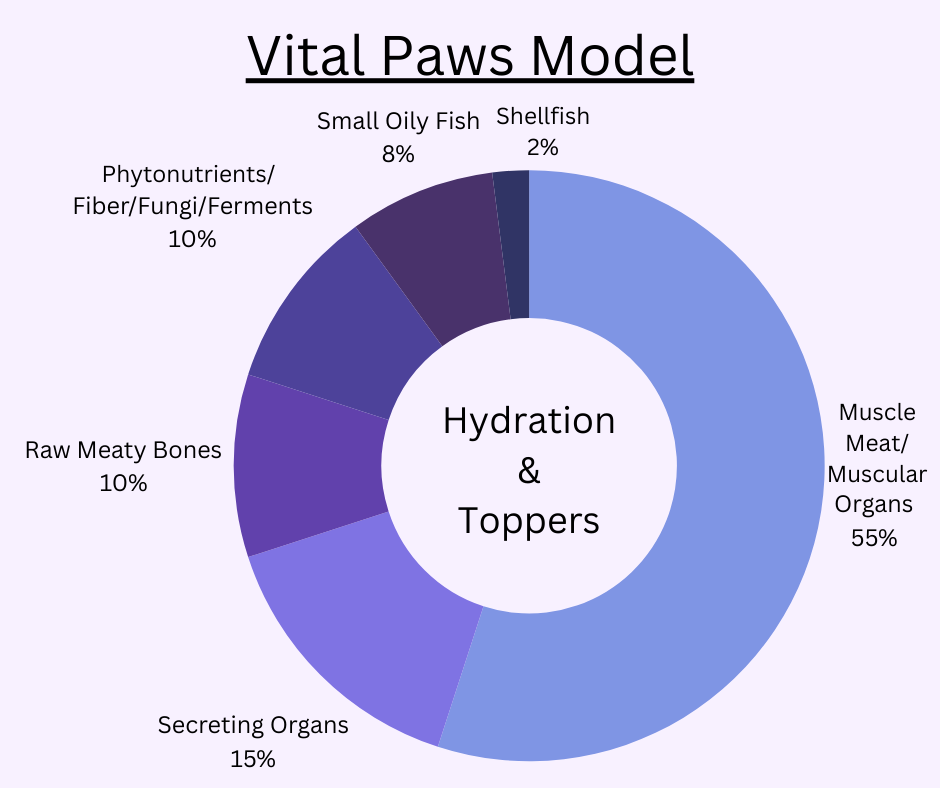
Here it is! This is the way I feed my dogs, and the way I instruct my clients- the Vital Paws Model! I created this model to target and optimize mitochondrial health. It has met the needs of the majority of those I’ve worked with and creates meals that come closest to a ‘balanced’ diet by AAFCO standards (not that I feel ‘complete and balanced’ by AAFCO is something we need to strive for- if you would like to learn more about AAFCO and their standards, watch my free Webinar entitled Lost in the Crunch!).
Mitochondria are present throughout the body, but particularly prevalent in the skeletal muscles, heart, brain and nerves. Our Mitochondria are nicknamed the “powerhouse of the cell” because they quite literally create energy 24/7, which is needed to support life. Sadly, our mitochondria are being constantly assaulted by daily exposure to toxins, stress, chemicals, medications, pesticides, sugar, inflammation, and lack of movement and exercise. Damaged or inefficient mitochondria can lead to insulin resistance, diabetes, pancreatic dysfunction, neuromuscular disorders, autoimmune disorders, chronic GI conditions, neurological decline such as dementia, and so much more.
The pillars of this diet include high quality lean proteins, healthy fats and fish, anti-inflammatory and low-glycemic vegetables, species appropriate fiber, phytonutrients and antioxidants. Combined, these support mitochondrial health in order to provide the body with the most efficient energy possible.
Let’s get into the nitty gritty of why I feel this ratio of ingredients is optimal:
- 55% muscle meat/muscular organs: as you can see, this amount is slightly lower than the Ancestral diet and the B.A.R.F. diet, and quite a bit lower than P.M.R. However, fish is technically muscle meat as well, so the true approximate amount of muscle meat being fed is closer to 65%. Since fish are so important, I felt it was necessary to give them their own category to emphasize the need for them in the diet, which is expanded below. Another major difference here is that I specify the use of muscular organs in this section. This can be heart, lung, tripe, etc., and can make up some or all of the muscle meat portion. I personally use 100% muscular organs as my muscle meat. These organs, especially heart, have similar but often slightly better nutrient profiles compared to cuts of skeletal muscle, plus heart is very high in taurine which is important for heart health!
- 15% secreting organs: here’s another unique difference from any of the other models. I use 5% liver and 10% other secreting organs. This provides more B vitamins and a few other minerals such as Potassium and Selenium, especially when using kidney. Organs are packed full of nutrients and have a different nutritional profile from muscle meat, so using a little bit more can really elevate the bowl.
- 10% RMBs: this section is pretty unchanged; I do like to emphasize cartilaginous bones as often as possible, such as necks, feet and wings. These types of bones are excellent for joint health and have also shown anti-cancer properties.
- 10% fiber/fungi/ferments/phytonutrients: this is a category I find to be especially important. Studies have shown that dogs who eat a diet devoid of plant matter have limited biodiversity in their microbiome which can lead to dysbiosis, so fiber in the form of low glycemic vegetables is important. Sadly, the amount of fungi in our diets (for dogs and humans!) has been drastically diminishing over the decades. Adding fungi back in not only provides prebiotics but also bolsters the immune system. Fermented foods are an excellent source of probiotics and are great for gut health. And finally, phytonutrients can provide much needed beneficial compounds that improve immune health and overall resilience.
- 8% small oily fish: in this category, i prioritize sardines, mackerel, herring and salmon, as these fish provide both Omega 3’s as well as Vitamin D. Other fish can be used, such as anchovy or smelt, but they do not provide Vitamin D. I’m more of a ‘two birds, one stone’ kind of girl, so I’m choosy with my fish.
- 2% shellfish: I have this separated because I feel that shellfish have amazing nutritional value and deserve their own category. You don’t need to feed much to get what you need. For example, 0.5oz of oyster provides enough daily Zinc for my 65lb dog, and 0.5oz of blue mussels does the same with Manganese. I use both of the aforementioned shellfish as well as clams when I can find them. Note that I do use steamed shellfish, not raw, for several reasons, including the risk of thiaminase. To learn more about that, read my blog on fish!
- Hydration & Toppers: This is in the middle because hydration is extremely important, and so many pet parent use toppers now (including me!) that they can’t be excluded.
- Hydration- water is an essential component of the diet. How you hydrate matters. I encourage you to read my blog article about Water to learn more about options. Additional choices for hydration include raw goat milk, kefir, and bone broth!
- Toppers- there are a few toppers that I use frequently. I generally include some kind of kelp/spirulina or other seaweed for iodine needs. I also like to sprinkle herbs into my containers, especially ones that support the liver. Those herbs may be fresh from my garden, or dried. Eggs are a daily to every-other-day topper for my dogs (the larger dogs are daily, my smaller dog is every other), never an afterthought. Sometimes I’ll use a supplement from a company as a topper, including Mycodog mushroom tinctures that I give in addition to fresh mushrooms in the fungi section. MCT oil or Coconut Oil from CocoTherapy is another topper that I love to use, as well as ION Gut Support from Intelligence of Nature.
There you have it- a breakdown of my model and my reasoning behind each category. I could go on and on about each ingredient far beyond what I’ve written here, but this article is already too long! If you want to use my model of feeding, or any of these models, check out my calculator. It’s currently being updated, but will be back online shortly for you to use.
As always, thank you for reading, thank you for your support, and thank you for being your pet’s best advocate. I’ll see you next time, and until then, have a super fantastic day!

